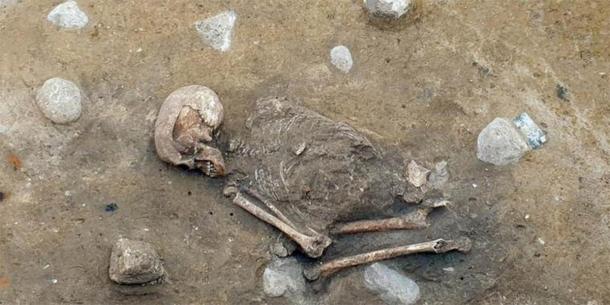‘Lady Of Bietikow’ May Have Died Of A Tooth Infection 5,000 Years Ago
In Germany, a middle-aged woman who died more than 5,000 years ago has been found. The Neolithic woman was found during excavations in the northeastern city of Uckermark for the construction of a new collection of wind turbines.
Experts are still seeking to ascertain aspects of her life, including her cause of death, nicknamed the ‘Lady of Bietikow‘ after the town she was found near.
As they were extremely worn, possibly a symptom of a fatal tooth infection, her teeth may provide clues, experts speculate. According to local media, the skeleton had been buried in a village in a squatting place, one of the oldest known forms of burial.

Investigations have shown that she was between 30 and 45 years old and died more than 5,000 years ago.
All that is left of Lady Bietikow are bones and some fragments of clothing, but researchers have still managed to piece together some details about her life.
During the time she was alive, during the Neolithic period, humans were just starting to eat grains, as they could be stored more easily than meat and could also be used as a means of payment, according to anthropologist Bettina Jungklaus.
However, this led to a deterioration in people’s general health. This can be seen in the state of the Lady of Bietikow’s teeth, which are severely eroded and missing completely in some places, Jungklaus said.

‘Normally there is enamel on the surface of the teeth. But here it is heavily worn, chewed off,’ she said.
‘This allows us to draw conclusions about her diet: it was probably very rich in fibre, very hard. There are certain grains that cause the teeth to wear out easily.’
It remains unclear whether the condition of Lady Bietikow’s teeth indicates an illness or even the cause of her death, and further analysis will aim to determine this.
Researchers are now hoping to find out more about her life, including whether she came from the Uckermark region or had immigrated there from elsewhere.
Both the Lady Bietikow and the famed skeleton ‘Oetzi the Iceman’ lived during the same period of time.
Oetzi is a stunningly preserved corpse that was found in 1991 by two hikers in the Oetztal Alps on the border between Austria and Italy.

His body was extremely well preserved, with organs, skin and other organic material still intact – researchers were even able to see what he had eaten hours before he died.
‘You can compare Oetzi and the Lady of Bietikow in terms of age,’ said Philipp Roskoschinski, one of the two archaeologists who made the discovery in the state of Brandenburg, which surrounds Berlin.
‘The discovery of Oetzi was much more spectacular due to the conditions of preservation,’ Roskoschinski said.
